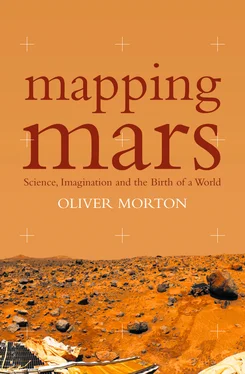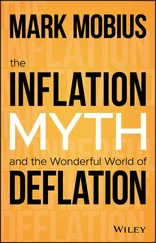Proctor’s names had two drawbacks, one immediately obvious, one revealed a decade later. The obvious drawback was that an unhealthy number of the people commemorated on Mars were now British. When the French astronomer Camille Flammarion revised Proctor’s nomenclature for his own map of 1876, various continentals – Kepler, Tycho, Galileo – were given grander markings. One continental on whom Proctor had looked with favour, though, was thrown off: perhaps influenced by the Franco-Prussian war, Flammarion resisted having the most prominent dark patch on the planet called the Kaiser Sea, even if Proctor had named it such in honour of Frederik Kaiser of the Leyden Observatory. The Hourglass Sea became an hourglass again, though this time in French: Mer du Sablier.
Proctor’s other problem was more fundamental. The features he had marked on his map, whatever their names, did not match what other people saw through their telescopes. In 1877, Mars was in the best possible position for observation; it was at its nearest to the sun (a situation called perihelion) and at its nearest to the earth (a situation called opposition), just 56 million kilometres away. Impressive new telescopes all over the world were turned to Mars and revealed its features in more detail than ever before. The maps based on observations made that year were almost all better than Proctor’s; and the map made by Giovanni Schiaparelli, a Milanese astronomer, on the basis of these observations, provided a new nomenclature that overturned all others.
Schiaparelli was not interested in celebrating his peers and forebears; he wanted to give Mars the high cultural tone of the classics. In the words of Percival Lowell, an American astronomer who was to make Mars his life work, it was an ‘at once appropriate and beautiful scheme, in which Clio [muse of poetry and history] does ancillary duty to Urania [muse of astronomy]’. To the west were the lands beyond the pillars of Hercules, such as Tharsis, an Iberian source of silver mentioned by Herodotus, and Elysium, the home of the blessed at the far end of the earth. Beneath them, part of the complex dark girdle strung around Mars below its equator, were the sea of sirens, Mare Sirenum, and Mare Cimmerium, the sea that Homer put next to Hades, ‘wrapped in mist and cloud’. Then we come to the Mediterranean regions: the Tyrrhenian Sea and the Gulf of Sidra (Syrtis Major, the long-observed hourglass) dividing bright Hellas and Arabia. Along the far side of Arabia sits the Sinus Sabeus, a gulf on the fragrant coast of Araby, home to the Queen of Sheba. Beyond Arabia begins the Orient, with Margaritifer Sinus, the bay of pearls on the southern coast of India, and the striking bright lands of Argyre (Burma) and Chryse (Thailand). Finally, in the dark region others had called the eye of Mars, Schiaparelli placed Solis Lacus, the lake of the sun, from which all dawns begin.
Do not think for a moment that this means a good classical education will help you find your way around Mars. For a start, due to the way telescopes invert images, everything is flipped around: Greece is south of Libya, Burma west of Arabia. What’s more, Schiaparelli’s geography was often more allusive than topographical. His planet is 360° of free association. Thus Solis Lacus is surrounded by areas named for others associated with the sun; Phoenix, Daedalus and Icarus. The sea of the sirens borders on the sea of the muses, presumably because Schiaparelli wanted to provide opportunity for their earthly feud to continue. Elysium leads to utopia.
For the most part he did not explain his nominal reasoning very exactly, but there are exceptions, most notably right in the middle of the map, at the point where dark Sinus Sabeus gives way to Sinus Margaritifer, somewhere between Arabia and the Indies, a place he called Fastigium Aryn. ‘As Mädler,’ Schiaparelli wrote, ‘I have taken the zero-point of the areographic longitudes there, and following this idea I have given it the name of Aryn-peak or Aryn-dome, an imaginary point in the Arabian sea – which was long assumed by the Arabic geographers and astronomers as the origin of the terrestrian longitudes.’
By the time he was through with Mars, Schiaparelli had given 304 names to features on its surface and though there was a Proctorite resistance – ‘Dawes’ Forked Bay it will ever be to me, and I trust to all who respect his memory,’ wrote Nathaniel Green, who painted a lovely map of Mars after observing the planet from Madeira during the opposition of 1877 – it foundered. Schiaparelli’s proper names were triumphant and have in large part lasted until today. It was his common nouns that caused the problems. Schiaparelli saw a large number of linear features on the face of the planet and called them ‘canali’ – channels. Schiaparelli claimed to be agnostic as to the nature of these channels – they might have been natural, or they might have been artificial. Percival Lowell, his most famous disciple, plumped firmly for the artificial interpretation.
Lowell’s reasoning went like this. Mars is habitable, but its aridity makes the habitability marginal; if there were intelligences on Mars, they would do something about this; the obvious thing to do would be to build a network of long straight canals. And since this is what we see when we look at Mars, this is what must have happened.
With this leap of the imagination, Lowell created one of the most enduring tropes of science fiction: Mars as a dying planet. It would live on in the works of H. G. Wells, Edgar Rice Burroughs, Leigh Brackett and many, many others. And if his interpretation of what he saw did not win as much favour among his astronomical colleagues as it did in the popular imagination, it was not because the idea of life on Mars seemed too far-fetched. Observations of the way the planet’s brightness and colour seemed to change with the seasons made plant life there seem almost certain; if plants, why not animals and why not intelligence? The most weighty argument against Lowell’s Martians was simply that over time other, better observers consistently failed to see the canals as continuous and linear, if they saw them at all. The lack of evidence of engineering, not the implausibility of life on Mars, was what counted against Lowell – a belief in life on Mars was quite commonplace.
Today this easy acceptance seems rather remarkable. At the beginning of the twenty-first century, when the possibility of life elsewhere has become the central preoccupation of space exploration, its discovery is routinely held up as the most important discovery that could ever be made. What accounts for this change?
A large part of the answer lies in the nature of astronomy. Copernicus’s proposal that the earth was not the centre of the solar system changed the way that astronomers looked at the sky. If the earth was no longer the fixed centre, then it was a wandering star like the five which shuffled back and forth across the zodiac: a planet. Previously unique, now it was one member of a class and must have similarities to its classmates. The world had become a planet and so the planets must become worlds, a process accelerated by the Galilean discovery that, like the earth, the planets were round and had features. In this context it was quite normal to believe that one of the things that the planets had in common was life, especially since, after Copernicus, many astronomers tended to go out of their way to deny the earth any special attributes. As Lowell put it in Mars (1896), ‘That we are the only part of the cosmos possessing what we are pleased to call mind is so earth-centred a supposition, that it recalls the other earth-centred view once so devoutly held, that our little globe was the point about which the whole company of heaven was good enough to turn. Indeed, there was much more reason to think that then, than to think this now, for there was at least the appearance of turning, whereas there is no indication that we are sole denizens of all we survey, and every inference we are not.’ A Copernican stance could easily lead astronomers to the assumption of life, not lifelessness, as the status quo.
Читать дальше












